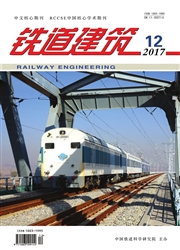

 中文摘要:
中文摘要:
A rigorous analytical method is presented, which takes into account the pile stiffening effects, using the theory of the transfer matrix-bottom rigidity for calculating the interaction factor between two identical piles in multi-layered soils subjected to vertical loads. Following the technique proposed by Muki and Sternberg, the problem is decomposed into extended soil layers and two fictitious piles characterized respectively by Young’s moduli of the layered soils and those of the differences between the piles and the layered soils. The unknown axial forces along fictitious piles are determined by solving a Fredholm integral equation of the second kind, which imposes the compatibility condition that the axial strains of the fictitious piles are equal to those corresponding to the centroidal axes of the extended layered soils. The real pile displacements can be calculated based on the determined fictitious pile forces, and finally, the desired pile interaction factors may be obtained. Selected results from parametrical studies are presented to confirm the validity of the proposed approach and portray the influence of the governing parameters on the pile interaction.
 英文摘要:
英文摘要:
A rigorous analytical method is presented, which takes into account the pile stiffening effects, using the theory of the transfer matrix-bottom rigidity for calculating the interaction factor between two identical piles in multi-layered soils subjected to vertical loads. Following the technique proposed by Muki and Sternberg, the problem is decomposed into extended soil layers and two fictitious piles characterized respectively by Young's moduli of the layered soils and those of the differences between the piles and the layered soils. The unknown axial forces along fictitious piles are determined by solving a Fredholm integral equation of the second kind, which imposes the compatibility condition that the axial strains of the fictitious piles are equal to those corresponding to the centroidal axes of the extended layered soils. The real pile displacements can be calculated based on the determined fictitious pile forces, and finally, the desired pile interaction factors may be obtained. Selected results from parametrical studies are presented to confirm the validity of the proposed approach and portray the influence of the governing parameters on the pile interaction.
 同期刊论文项目
同期刊论文项目
 同项目期刊论文
同项目期刊论文
 期刊信息
期刊信息
